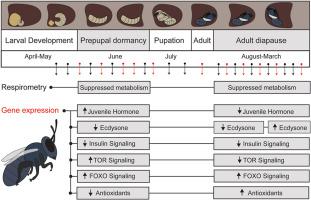Insect Biochemistry and Molecular Biology ( IF 3.8 ) Pub Date : 2024-01-14 , DOI: 10.1016/j.ibmb.2024.104074 Dacotah Melicher , Alex S. Torson , George D. Yocum , Bosch Jordi , William P. Kemp , Julia H. Bowsher , Joseph P. Rinehart

|
The solitary bee Osmia lignaria is a native pollinator in North America with growing economic importance. The life cycle of O. lignaria provides a unique opportunity to compare the physiological and molecular mechanisms underlying two ecologically contrasting dormancies within the same species. O. lignaria prepupae become dormant during the summer to avoid high temperatures. Shortly after adult eclosion, they enter a second dormancy and overwinter as diapausing adults. To compare these two dormancies, we measured metabolic rates and gene expression across development as bees initiate, maintain, and terminate both prepupal (summer) and adult (overwintering) dormancies. We observed a moderate temperature-independent decrease in gas exchange during both the prepupal dormancy after cocoon spinning (45 %) and during adult diapause after eclosion (60 %). We sequenced and assembled a high-quality reference genome from a single haploid male bee with a contiguous n50 of 5.5 Mbp to facilitate our transcriptomic analysis. The transcriptomes of dormant prepupae and diapausing adults clustered into distinct groups more closely associated with life stage than dormancy status. Membrane transport, membrane-bound cellular components, oxidoreductase activity, glutathione metabolism, and transcription factor activity increased during adult diapause, relative to prepupal dormancy. Further, the transcriptomes of adults in diapause clustered into two groups, supporting multiple phases of diapause during winter. Late adult diapause was associated with gene expression profiles supporting increased insulin/IGF, juvenile hormone, and ecdysone signaling.
中文翻译:

独居蜂 Osmia lignaria 夏季和冬季休眠的代谢和转录组特征
独居蜂Osmia lignaria是北美本土的传粉媒介,其经济重要性与日俱增。O. lignaria的生命周期提供了一个独特的机会来比较同一物种内两种生态对比休眠的生理和分子机制。O. lignaria prepupae 在夏季进入休眠状态以避免高温。成虫羽化后不久,进入第二次休眠,并以滞育成虫越冬。为了比较这两种休眠,我们测量了蜜蜂启动、维持和终止蛹前(夏季)和成虫(越冬)休眠时的代谢率和整个发育过程中的基因表达。我们观察到,在结茧后的预蛹休眠期间(45%)和羽化后的成虫滞育期间(60%),气体交换出现了与温度无关的适度减少。我们对来自单个单倍体雄蜂的高质量参考基因组进行了测序和组装,其连续 n50 为 5.5 Mbp,以方便我们的转录组分析。休眠预蛹和滞育成虫的转录组聚集成不同的组,与生命阶段的关系比与休眠状态的关系更密切。与蛹前休眠相比,成虫滞育期间膜运输、膜结合细胞成分、氧化还原酶活性、谷胱甘肽代谢和转录因子活性增加。此外,滞育成虫的转录组分为两组,支持冬季滞育的多个阶段。成年晚期滞育与支持胰岛素/IGF、保幼激素和蜕皮激素信号传导增加的基因表达谱相关。



























 京公网安备 11010802027423号
京公网安备 11010802027423号